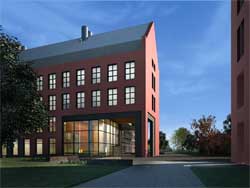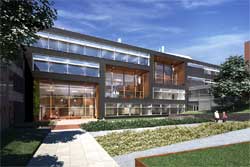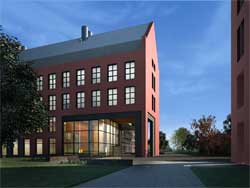KINGSTON, R.I. – October 5, 2009 – When Fogarty Hall opened as the new home of the College of Pharmacy at the University of Rhode Island in 1964, it was designed to accommodate 150 students.
 This semester, the 700 students and 45 faculty members in URI’s pharmacy college squeeze into this outdated facility. Fogarty Hall also houses a premier statewide biomedical research laboratory, an outreach program that provides thousands of senior citizens with medication counseling at no cost to them, a patient simulation lab and the Rhode Island State Crime Laboratory.
This semester, the 700 students and 45 faculty members in URI’s pharmacy college squeeze into this outdated facility. Fogarty Hall also houses a premier statewide biomedical research laboratory, an outreach program that provides thousands of senior citizens with medication counseling at no cost to them, a patient simulation lab and the Rhode Island State Crime Laboratory.
Today, after many years of planning, federal, state and University officials broke ground on a $75 million complex that will allow the College of Pharmacy to grow in its role as a center of excellence in teaching, learning, and research, and as a centerpiece of the state’s efforts to build an economic recovery that relies on biomedical research and other scientific efforts.
“This state-of-the-art facility will pave the way for us to expand our work in training a new generation of pharmacists, growing our state’s research capacity and generating groundbreaking discoveries,” said Governor Donald L. Carcieri.
The governor said the college has long enjoyed a tradition of excellence and by providing it with a new home, “we are further enhancing its image and we are ensuring that it can meet the University’s growing needs.”
Carcieri pointed to successes in building the state’s science and research capacity and the strategic investments being made in higher education.
“This year alone we dedicated the $54 million Center for Biotechnology and Life Sciences here as well as the $15 million Ocean Science and Exploration Center and Pell Marine Science Library. And, today, we build upon our science and biotechnology nucleus and contribute to building an innovation economy,” continued Carcieri.
The 148,000-square-foot, five-story building will allow the college to accept more students in its six-year doctor of pharmacy degree, its graduate programs and its four-year bachelor’s degree in pharmaceutical sciences, which was launched this semester. As the most selective college at URI, the College of Pharmacy typically enrolls about 95 students annually in its doctor of pharmacy program from an applicant pool of more than 1,000.
 The new building will allow URI to pursue its goal of increasing enrollment in the doctor of pharmacy program by 30 percent over the next several years. Additional students will be enrolled in the bachelor’s program in pharmaceutical sciences, which will develop professionals to work in the pharmaceutical industry and within health systems to manage health service delivery.
The new building will allow URI to pursue its goal of increasing enrollment in the doctor of pharmacy program by 30 percent over the next several years. Additional students will be enrolled in the bachelor’s program in pharmaceutical sciences, which will develop professionals to work in the pharmaceutical industry and within health systems to manage health service delivery.
The future home of the College will house the latest research spaces designed to foster interaction and teamwork. Tissue culture rooms and dedicated technology zones within eight-person research modules will support the research laboratories. The teaching spaces include a 165-seat auditorium, two 30-seat classrooms, a 60-seat classroom, a patient simulator center and three teaching laboratories.
A key element of the new building is the location of undergraduate teaching and learning spaces on all floors so that students can be exposed to faculty researchers who are among the leaders in their fields. Interdisciplinary education of pharmacists and nurses, already well in place at URI, will enhance team driven care that is projected to be the model as health care reform moves forward.
Critical hands-on teaching, learning and research facilities now housed in Fogarty, such as the 3-D visualization auditorium, the statewide core laboratory for the biomedical research network that involves nearly all of the state’s four-year colleges, and the patient simulation center will be housed in larger, technologically advanced spaces. An intravenous preparation lab will be a feature in the new facility.
URI President David M. Dooley emphasized the importance of such a facility to the state.
“The University of Rhode Island is a real engine for the economic recovery of Rhode Island,” Dr. Dooley said. “Programs at the University of Rhode Island are geared toward education, research and outreach. This new building represents an important investment in research and education by both the state and the private sector. It’s an investment that will provide a great return to the people of Rhode Island.”
When it opens in 2011, the new home of pharmacy at URI will be the largest academic building. Today’s groundbreaking follows the opening last winter of the Center for Biotechnology and Life Sciences, which was the first structure to open in the health and life sciences north district.
The facility is being supported by $65 million in general obligation bonds overwhelmingly approved by Rhode Island voters in 2006, and a $10 million campaign for private donations.
Already, more than $4.1million in gifts and pledges provided by more than 200 alumni, friends and corporate supporters of the college has been raised. The total includes substantial contributions from Thomas M. & Cathy H. Ryan, Lois Vars Mason and William B. Mason, Brian K. Dallaire, the Mario Family Foundation, the Omar Family Magnate Foundation, CVS Caremark Corporation and Teva Pharmaceuticals USA, Inc.
“This is a tremendous day for URI and for those of us who set our sights on the goal of building a state-of-the-art school of pharmacy in Rhode Island,” said Ryan, chairman, president and chief executive officer of CVS Caremark. “With the aging of the population and continual advances in pharmacy health care, pharmacists play a key role as part of the health care delivery team. We are pleased to help in preparing them for their careers as trusted health care advisors.”
To make way for the project and a new north district quadrangle, three existing structures within the north district, the Biological Sciences Complex, the DeWolf Laboratory and the Tyler Hall north annex will all be razed. Operations from those facilities are being housed in newer facilities, including the biotech center.
“Today’s ceremonies mark a continuation of the University’s commitment to improving the health of Rhode Island residents and those beyond our state’s borders when it opened the College of Pharmacy in 1957,” said Ronald P. Jordan, dean of the College of Pharmacy. “This new building will improve our ability to educate more pharmacists with the latest technological tools, as well as prepare new generations of biomedical researchers who will attack the scourges of our time: cancer, diabetes, Alzheimer’s, obesity and many other diseases and conditions. We will be able to expand our outreach to the elderly, our new training program for pharmacist-immunizers and facilities for our researchers, many of whom are known around the world for their work.”
The landscaping will include the new formal quadrangle to the building’s north and the College’s extensive medicinal garden to the south, with more than 200 species of medicinal plants. The garden is a commitment to the college’s internationally renowned natural products research program.
The building has been designed to meet standards for Leadership in Energy and Environmental Design (LEED) Silver certification. While it is a challenge to construct environmentally friendly facilities with substantial space dedicated to research, URI, working with its architect, has included a number of energy saving technologies while still meeting the needs of the college.
The building’s architect is Payette of Boston and the contractor is Suffolk Construction Co. Inc. of Boston.
Pictured above
The new College of Pharmacy building rendering shows the brick exterior on the north side of the building, which complements the nearby Center for Biotechnology and Life Sciences. Renderings courtesy of Payette of Boston, architects.
The new College of Pharmacy building rendering depicts the south side, which is dominated by walls of glass and overlooks the medicinal garden. Renderings courtesy of Payette of Boston, architects.

